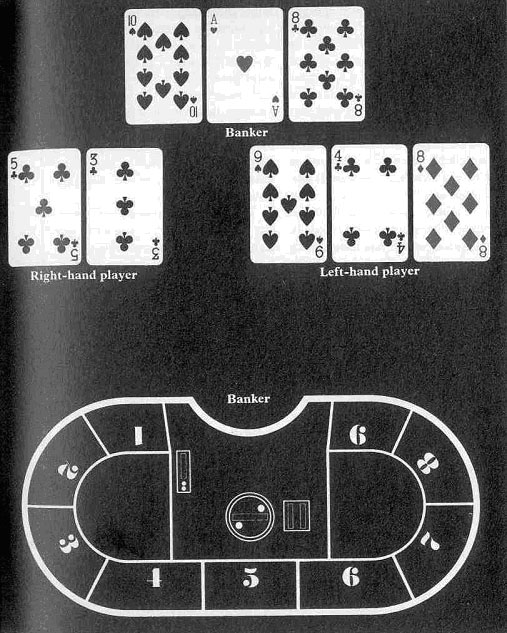BANKING GAMES
BACCARAT
BACCARAT, more correctly Baccarat Banque, is a game of chance that is played in casinos everywhere.
NUMBER OF PLAYERS
The game may be played by any number up to 30 or more
CARDS
Six packs of cards are shuffled together (in Las Vegas eight packs are used ) cut and placed in an open-ended box known as a shoe, designed to release only one card rank in value at 10 points each; all other cards at their pip values.
THE PLAY
The banker sits midway down one of the sides of a long, oval table (see illustration), and the players sit in equal numbers on both sides of him. those for whom there is no poker room to sit, stand behind them.
The banker, who is also the dealer, puts his stake on the table in front of him, and any player who wishes to bet against the whole of it calls ‘Banco’. If two or more call, the one nearest to the banker’s left makes the bet. If no-one calls, the players combine their bets to equal the stake put up by the banker.

The layout of the staking table used in baccarat and chemin de fer.
The banker then gives a card face downwards to the player on his right, a card to the player on his left and a card to himself. He repeats the operation so the three of them have two cards each.
The banker looks at his two cards and if he has a point of 8 or 9 he shows his cards and wins the hand. If he has not got a point of 8 or 9, he announces that he will give and the player on his right looks at his cards. If he has a point of 8 or 9 he shows his cards and announces his natural.
If he has not got a point of 8 or 9 he may ask for one more card which the banker gives to him face upwards. The player on the left of the banker goes through the same performance, and then the banker may, if he chooses, take one more card. Finally, the banker wins or loses to each player according to whose point is nearer to 9; equality neither wins nor loses.
To illustrate. The banker holds ♠ 10 and ♥ A, making a point of 1, and he, therefore, must give. The right-hand player holds ♣ 5 and ♣ 3. He faces his cards, announces his natural point of 8, and must win. The left-hand player holds ♠ 9 and ♣ 4, making a point of 3.
He must draw poker and the banker gives him ♦ 8, reducing his point to 1. For the moment, however, the left-hand player does not announce his point. The banker faces his cards, and, as he holds no more than a point of 1, he draws a card. It is the ♣ 8, which raises his point to 9.
The banker, therefore, wins from the left-hand player, but loses to the right-hand player, but loses to the right-hand player because though the banker has a point of 9, against the point of 8 held by the right-hand player, a natural beats any point made by the addition of a drawn card.
The rules of play poker are strict. They should never be deviated from because the player who is holding the cards is playing for all on his side of the table. If he deviates from the rules, and thereby loses the hand, he is liable to make good all losses incurred through his error.
A player must not look at his cards until the banker has either announced that he holds a natural he must expose his cards and declare his natural at once. If a player does not hold a point of 4 or less, stand if he holds a point of 6 or 7, and use his discretion to draw or stand only if he holds a point of 5.
